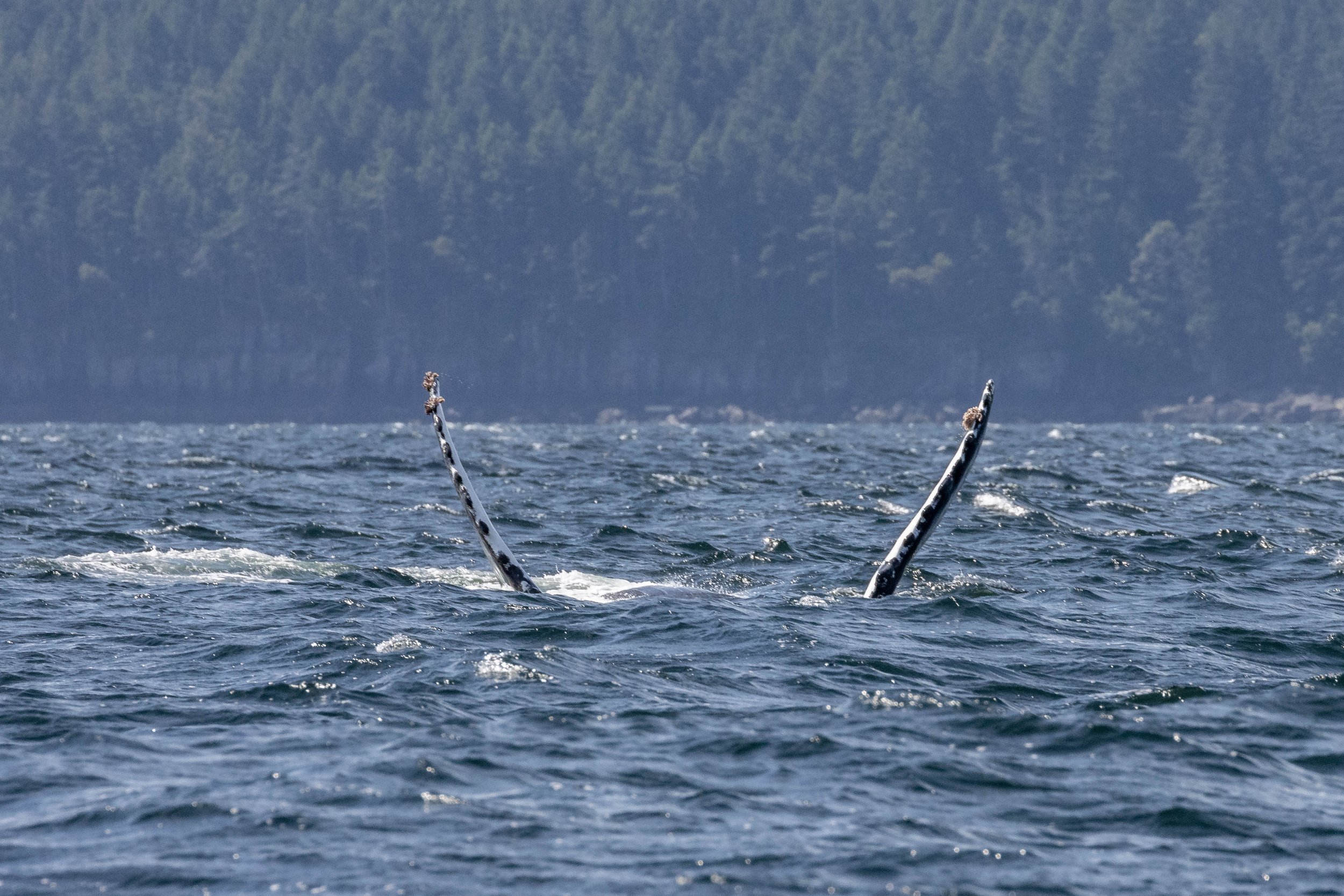July 1, 2024, 10:30 AM - A Very Humpback Morning.
We eagerly pushed off the dock with our eyes peeled and started searching the Salish Sea for our big friends! None of our whales are tagged, chipped or tracked so we find them each day with just our eyes! We do a few things when searching to increase the chance of spotting a whale.
The Humpbacks let out a big bushy blow that towers above the water's surface. Although this blow is large and looks like smoke, it is the easiest to spot these blows against the darker horizon, we scan the horizon constantly. The Humpbacks’ tail is about 20 feet across so if we miss the blow sometimes this large tail rises out of the water before the Humpback dives, called fluking. We can sometimes find them this way as well! If they are active and displaying multiple behaviours such as tail slapping, tail lobbing, cartwheeling, chin slapping, pec slapping or breaching the big splashes usually tip us off! On this tour, one boat spotted a blow, while the other spotted splashes. The blow was spotted not too far from home along the shores of Valdes Island.
Who was it? Our onboard Naturalist with a camera in hand got ready to take some photos of the dorsal fin and tail, they are unique to each whale and this is how we identify them. This tail belonged to BCY0770 Snoopy also known as Lunar or Gibbous. Snoopy migrates to Hawaii each year and is documented in their waters also, this is how Snoopy got multiple nicknames! Snoopy was most likely feeding when we spotted them, as Snoopy has just made a long journey and on top of that would have been fasting for 3 to 6 months! Each humpback needs to eat anywhere from 3000 - 5000 pounds of food per day. This is so Snoopy can build up fat reserves for the migration back to Hawaii at the end of summer/fall. The other humpbacks we saw today were spotted by their splashing, these two splashing up a storm were BCX1416 calf 2022 and BCY0324 calf 2022 Moresby. Two young whales were both born in 2022, maybe that explains their energy! These two were having fun today, or it sure seemed like it. Less focused on feeding than Snoopy. Our best guess is they filled their bellies and had a bit of a celebration to burn off some calories. After their rambunctious display calmed we watched them having a little nap/rest. Just like us humans, we eat a big meal and then grab a little shut-eye!
After spending time with the whales, we continued on our way to see what else would be in store for us along our journey. After some searching, we were able to find some River Otters playing along the Valdes Island shoreline. They were along the same spot where the Seals and Sea Lions typically spend time, a reef we have dubbed “Stinky Rocks”. It wasn’t just the River Otters that were there, but also a majestic Bald Eagle! Sharing these same rocks were the Steller Sea Lions today, just as Smelly and entertaining as ever. As we looked a little closer at the rocks closer to Valdes Island, we also spotted some of the adorable little Harbour seals! 4 species in one stop is pretty good!
Leaving Stinky behind, we had one final stop at the Gabriola Bluffs, getting to see the Bald Eagle nest and the nesting cormorants. Overall a great day out on the Salish Sea!
Please enjoy the photos below taken by Marine Naturalists Desarae Poier, Lucy Willis and Aly Kohlman.
KEY0048 swimming upside down pec slapping. Photo by Des Poier.
Another shot of KEY0048's pectoral fins. Photo by Des Poier.
Did you know that these pectoral fins can reach about 5 meters long. Photo by Des Poier.
The side of KEY0048 as they show part of their tail and one pectoral fin. Photo by Des Poier.
KEY0048 swimming sideways. Photo by Des Poier.
A great look at the underside of KEY0048’s tail flukes. Photo by Des Poier.
KEY0048 doing a little back dive. Photo by Des Poier.
If there was less water here we might be able to tell KEX0048’s sex! Photo by Des Poier.
A beautiful dive from KEX0048! Photo by Des Poier.
KEX0048’s pectoral fin. Photo by Des Poier.
KEX0055 Moresby. Photo by Des Poier.
Moresby’s Pectoral Fin. Photo by Des Poier.
KEX0048’s pectoral fins and a spy hop from Moresby. Photo by Des Poier.
Moresby (left) and KEY0048 (right) surfacing together. Photo by Des Poier.
KEX0048 doing a little spot hop beside Moresby’s pectoral fin. Photo by Des Poier.
A bald eagle with a bad hairdo. Photo by Des Poier.
A lovely look at a River Otter. Photo by Aly Kohlman.
A River Otter on the rocks at Stinky. Photo by Aly Kohlman.
A very playful looking sea lion. Photo by Aly Kohlman.
A big male Steller Sea Lion on Stinky Rocks. Photo by Aly Kohlman.
A great look at how photogenic the Steller Sea Lions are. Photo by Des Poier.
Harbour Seals on Stinky Rock. Photo by Aly Kohlman.
Snoopy going for a dive. Photo by Aly Kohlman.
Snoopy’s Dorsal fin as he surfaced in the Strait. Photo by Aly Kohlman.
The underside of Snoopy’s tail shows scarring from entanglement. Photo by Lucy Willis.
Snoopy’s left dorsal fin. Photo by Lucy Willis.
Snoopy has a very distinct dorsal fin. Photo by Lucy Willis.
The underside of Ocular’s tail flukes. Photo by Aly Kohlman.
Large Male Steller Sea Lion on Stinky Rocks. Photo by Lucy Willis.
The male diving into the water. Photo by Lucy Willis.
A Bald Eagle on the top of tree at the Gabriola Bluffs. Photo by Lucy Willis.
Pelagic Cormorants on the bluffs. Photo by Des Poier.
The whale watchers on Keta spending time on Keta. Photo by Lucy Willis.

































